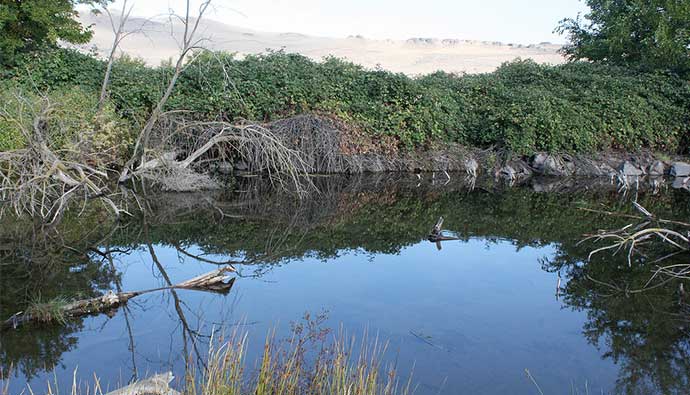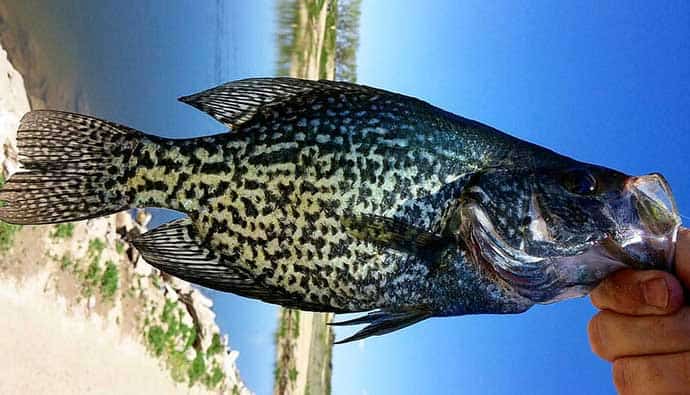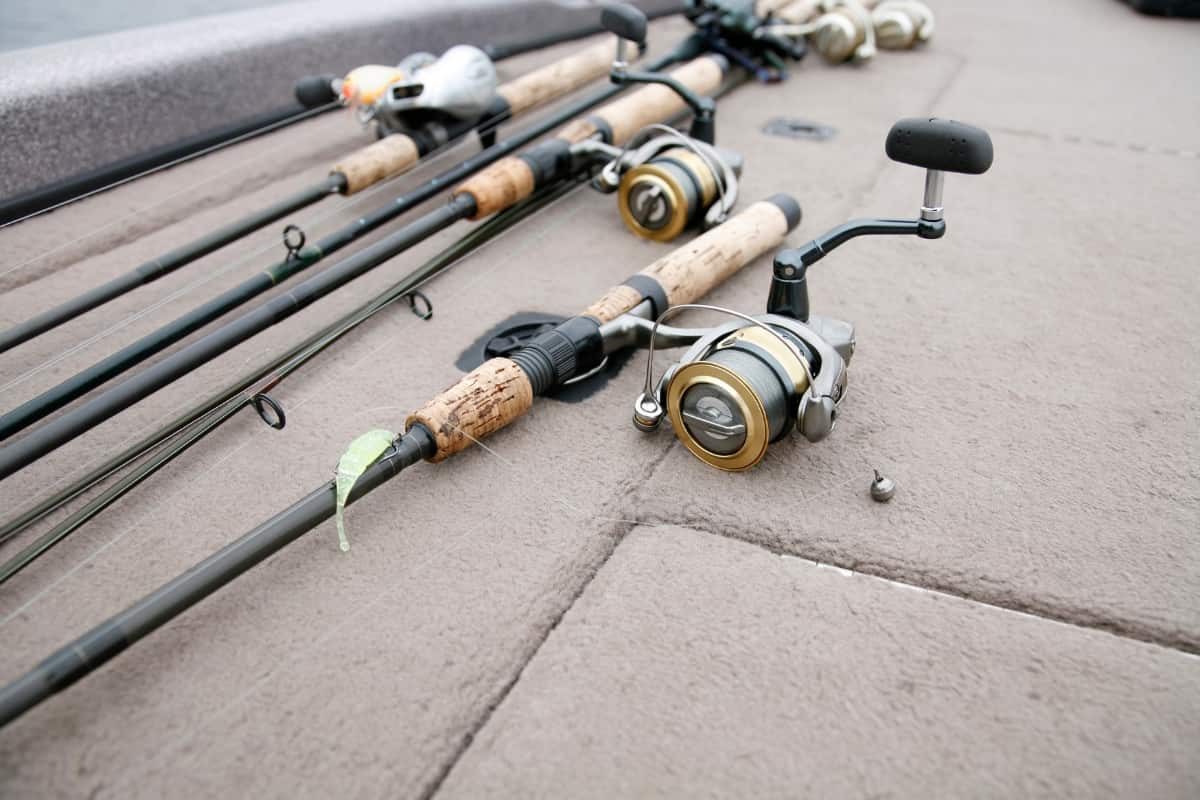Have you ever been bass or catfishing and realized you want something slightly different?
Well, for many people, the answer is crappie fishing. Crappies are entertaining and delicious fish to catch!

They fight hard, and it can be somewhat challenging to get to the boat from the depths of your favorite body of water.
Plus, they can be found in almost every body of water in North America. Use these crappie fishing tips to help you land this fantastic fish!
Overview
Crappies are in the genus Pomoxis, which is a North American freshwater fish in the family Centrarchidae, which is the sunfish family.
Crappie Fish Facts
There are only two currently recognized species in the Pomoxis Genus. They are the Pomoxis annularis, the White Crappie, the Pomoxis Nigromaculatus, and the Black Crappie.
Both Species of crappie, when adults feed mainly on smaller species, including the young of the species that regularly feed on them. Including but not limited to the Northern Pike, Musky fish, Largemouth Bass, and Walleye.
Crappie Diet and Movement Patterns
However, they have very diverse diets, including zooplankton, insects, and crustaceans.
During the day, crappie tend to be less active and with stay around weed beds or submerged objects.
Dusk and dawn are when crappie moves into the open water or approach the shore to feed.
Crappie starts spawning when the water reaches the mid 50’s temperature; they generate twice a year and begin staging beds in 6-15 feet of water.
Crappie is an American sportfish that rivals largemouth bass in many places in the United States.
The world record white crappie (Pomoxis Annularis) weighed in at 5.2 lbs, and the world record Black Crappie (Pomoxis nigromaculatus) weighed in at 5.0 lbs.
A bonus, crappie are some of the most delicious freshwater fish a person can eat. They have tender, flaky white meat that is very delicate when cooking.
Where Are Crappie Found?
When looking for Crappie, you need first to distinguish what crappie species you are looking for.

Black crappie can handle water that is deeper and clearer than white crappie can. They also love cold water; this information will help you choose which kind of crappie you will be going after.
Your best bet when looking for crappie is to look for the more extensive ponds and the shallower parts of lakes with sand and mud on the bottom.
Lakes hold a large amount of crappie due to the diverse ecosystem; plenty of forage and cover allow crappie to grow to cast iron skillet-sized portions!
The Key to Finding Crappies
Look for
- laydowns
- underwater trees
- inlets, points
- sunken islands
- holes
- dams
- vegetation
These types of covers are crucial to finding the perfect crappie hole!
Underwater structures create shallows that allow vegetation to grow underwater, attracting small baitfish that use it for cover from predators.
Crappie is in most freshwater waterways in North America, as well as many anglers have been stocking them in ponds to replace largemouth bass for decades.
Crappie Fishing Tips
When an angler decides he will go for crappie, they’ll need to pick a light action rod with a small 500-1000 model reel that is spooled with a 2-6 lb test.
This is because crappie has small mouths, although they have the biggest of the sunfish family.

Remember that Crappie has a mouth as thin as paper that rips easily! So do not set your drag all the way and let the fish wear itself out!
Fishing for crappie is prevalent throughout most of North America.
How to Catch
There are many methods, but the most popular is spider rigging.
This method is characterized by an angler in a boat with many fishing rods pointing away from the angler at different angles, like the spokes in a bicycle wheel.
Fly fishermen target crappie during the spawning period in shallow creeks. Ice fishermen target crappie regularly because they are still active in the colder frigid water.
Jig Fishing For Crappie
Usually, 1/8 oz Crappie jigs are used, but anglers have been known to use a Crappie jig down to 1/64 oz for a more finesse approach if they are hitting a little softer on a given day.
As far as soft plastics go, a small 2-inch grub or small paddle tail swimbait is the best crappie jig on a day they are feeding hard.

However, on a day where finesse is required, a 1-inch minnow or another 1-1.5 inch micro lures do wonders on crappie that are holding to cover if you use a vertical jigging method.
When vertical jigging, you need to be near or right beside the piece of cover you will be fishing at; start right against the wall and let the bait fall to the bottom.
Once you do this, you need to pull the bait up to you in a fluid up-and-down motion, slowly reeling in.
Crappie Water Considerations
If the water is fairly straightforward, try and keep your soft plastics natural-colored; keep the plastics as close to what the fish would be feeding on naturally.
On sunny days, the fish get a large amount of light penetrating the water. These days you can pick just about any color you wish, but bright colors like yellow, chartreuse, and electric pink should be your go-to.
When the water is darker, you will need to pick bright colors; anything that reflects light is a good choice, as there is not much in the water for the crappie to see.
If you are fishing with cloudy or overcast skies, you need to go a little darker with your baits, but you still need to choose something that has a small amount of brightness to it, whether a spinner or a chartreuse tail.
If switching your colors is not working, try using a maribou jig. They are fly-like jigs made out of either synthetic hair or deer hair.
Maribou jigs pulsate through the water as you retrieve them.

Crappie Fishing Baits
An angler should never underestimate the use of live bait when they are targeting crappie.
Great Crappie Baits
- worms
- minnows
- insects
- about anything that will catch crappie’s attention will work.
You do not have to be worried about the bait’s color; you are simply throwing them what they would be eating anyway.
Minnows are the best at catching slabs out of the depths when it comes to crappie bait!
Most anglers use a simple slip-sinker bobber with a small split shot and a hook ranging from a size 12 up to a size one bait holder hook.
Filleting and Cooking Crappie
- To begin, you need an excellent sharp filleting knife.
- Cut behind the gill cover on both sides. Run your knife along the top of the back fin to the tail on both sides.
- Once you have made those cuts take your knife and run it along the backbone; once you reach the end of the ribs, push your blade through till it comes out of the bottom on both sides.
- Start gently on the fillet you have started cutting, and slowly detach the meat from the rib cage with your knife.
- Once you have your fillets cut off, be careful as the skin is fragile; start cutting the meat off the skin and hold both in place while you run your knife along the skin; once completed, you have an utterly bone-free crappie fillet!
Crappie Recipes
I always like to browse the web for the best crappie recipes. I stumbled upon these two from the Crappie Fisher. Not the worst way to enjoy your catch!
Classic Pan-Fried Crappie
Ingredients
- 6 Crappie fillets 1 cup buttermilk
- 1 cup cornmeal
- 1/3 cup flour
- 1tsp baking soda
- 1 tsp garlic powder
- 2 cups of vegetable oil
- Salt
- pepper
- Potato
- Start by fileting your crappie and then soaking them overnight in salt water.
- This helps to keep the meat of the fish nice and tender for cooking when caught fresh. Otherwise, the meat can go soft and mushy if not soaked in saltwater!
- Place the crappie filets into a glass bowl and pour in the buttermilk and generously coat each filet. Cover the bowl and allow the filets to soak for a few hours in the refrigerator for between 2 to 4 hours. Combine the flour, cornmeal, baking soda, and garlic powder in a smaller bowl and season with salt and pepper.
- Take out the crappie from the refrigerator and dip each fillet into the flour mixture, giving a generous coating for each filet.
- Heat the vegetable in a large skillet, heating to 350 degrees. Ensure the pan is deep enough to submerge each filet in oil completely.
- Dip the fillets into the skillet and fry for a few minutes on each side – only fry 2-3 at a time to ensure the oil doesn’t overspill. Once fried for a few minutes, remove the crappie from the skillet and place it on a paper towel to soak up some of the excess oil. Garnish with a slice of lemon, and enjoy!

Pan-Seared Crappie
Ingredients
- 6 crappie filets
- 1 tbsp butter
- 1tsp parsley
- 1 tsp salt
- 1 tsp pepper
- 1 lemon
- Potato
While pan-fried crappie is unquestionably delicious, there are other frying methods worth a try, including this pan-seared crappie recipe.
It’s much lighter than pan-fried and really brings out the rich flavor of the crappie meat.
- Start by filleting the crappie before soaking them overnight in salt water if caught fresh – which hopefully most of you have done! Once left overnight, remove the filets from the saltwater. Season with salt and pepper.
- Melt the butter in a heavy skillet over high heat, allowing it to just begin to caramelize before reducing the heat to medium. Cook the crappie in the skillet, sticking to 2-3 at a time for the best results. Cook for a few minutes on either side, turning several times if necessary.
- You want the meat to take on a flaky texture – constantly monitor it to ensure it doesn’t overcook! Once cooked, garnish the crappie with sliced lemon and fresh parsley!
Insider Advice
Now that you know some fantastic crappie fishing tips and how to catch them, I hope you will go out and try your hand at catching these delicious fish yourself!
Crappie fishing is a great way to get a little bit of change in your standard fishing types.
Crappie fishing, hands down, is one of the most fun and challenging types of fishing! Not to mention how cheap it is to get into.
If you have any tips that I missed in this article for catching crappie, let me know in the comments below :).





 Facebook
Facebook YouTube
YouTube








